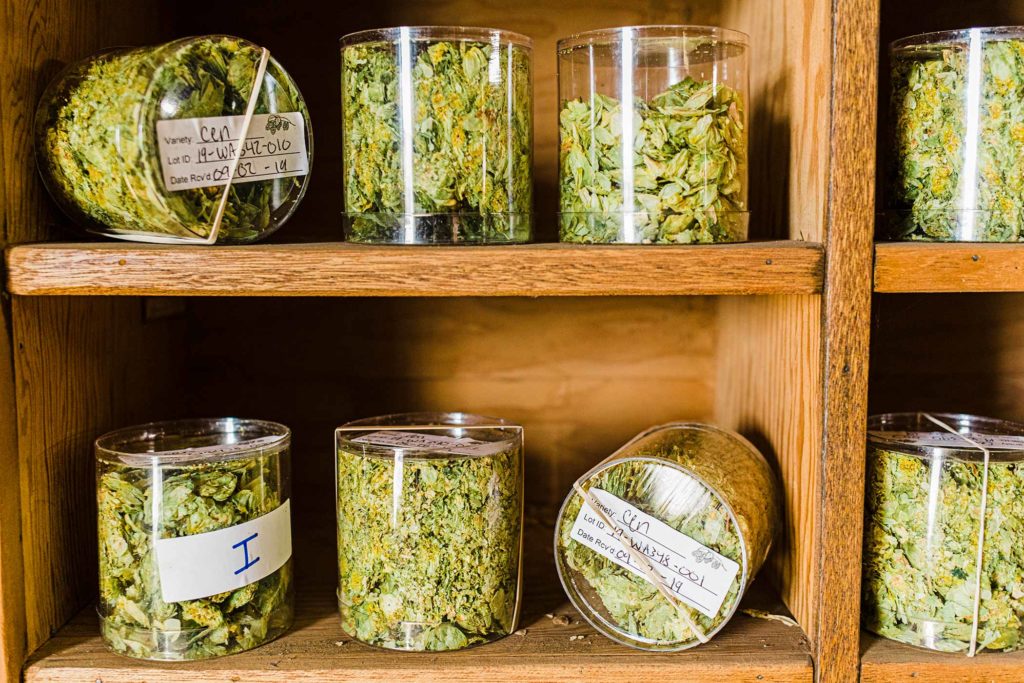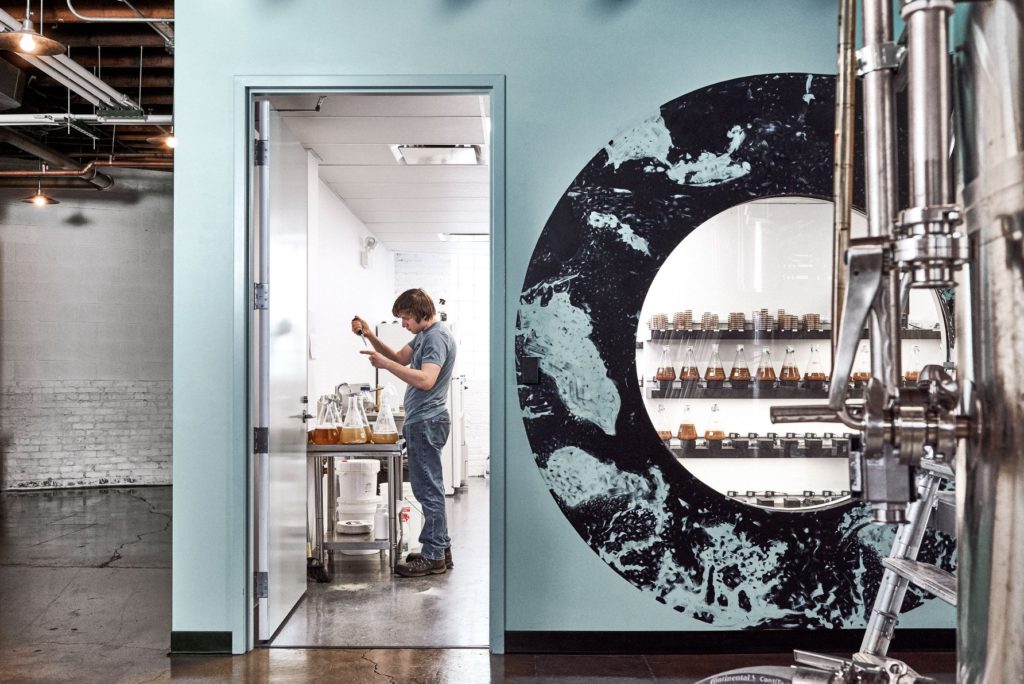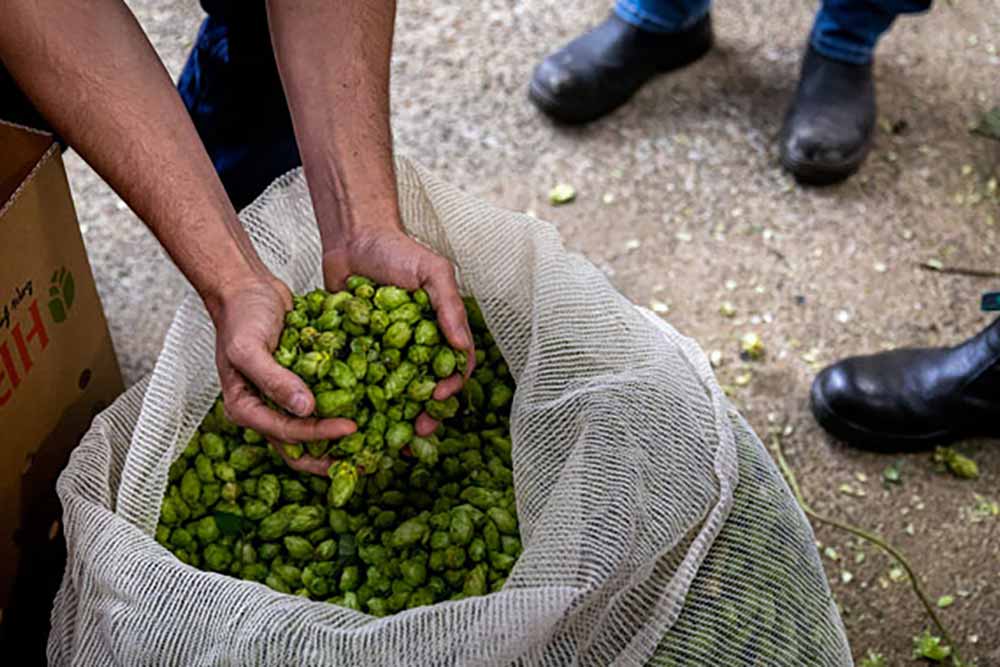
Biotransformation—a buzzword making the rounds through the brewing industry—can make your beer more flavorful and aromatic. But what is it exactly? Sometimes when approaching something as complex as biotransformation, it’s best to take a step back and simplify things.
Following the German Purity Law for beer, we use these essential ingredients to make beer: water, barley, hops, and yeast.
Yeast ferments the grains to create the alcohol and carbon dioxide, and the hops lend a bitter bite, flavor, and aroma from their essential oils.
But that’s not the only thing that yeast and hops can do. During that fermentation, yeast will release enzymes, where biotransformation comes into play.
In layman’s terms, biotransformation in brewing is when yeast takes the not-so-great flavors of hops and makes them palatable aspects of the beer, creating rich flavors and aromas.
But you don’t want layman’s words. We spoke with experts on biotransformation from Berkeley Yeast, John I Haas, and Founders Brewing, who can explain the complexities and nuances of biotransformation and why understanding this science will make you better brewers and help you brew better beer.
What We’ll Cover in This Piece:
Affordable, Industry-Leading Brewery Software
What Is Biotransformation?

Photography courtesy of Omega Yeast
“You might ask seven different brewers what they think biotransformation is, and you’d get at least eight answers,” John I Haas Research Scientist Julia Jennings says, calling the process of biotransformation a “sticky subject.”
Jennings explains how one could argue that fermentation itself could be classified as biotransformation but said that process is mainly excluded from the definition of biotransformation.
“Mostly what we’re talking about with biotransformation are pretty simple chemical reactions, and it’s kind of in the name,” she says. “The bio part is that it’s typically done by yeast or some other microorganisms in the beer. And then the transformation is that small chemical reaction transforming it from one thing to another.”
Some examples, Jennings cited, are thiol and terpene transformations. She says that there are enzymes mostly coming from the yeast but also from hops.
“Even water can act as catalysts; any kind of acid or base can catalyze some of these reactions. But typically, these are enzymes from the yeast,” Jennings says of biotransformation.
A lot of biotransformation is enzymes that are present in yeast. For thiols, that means cleaving a bond to free that aroma-enhancing compound so it makes it to your nose, according to Jennings.
“I think that often people are talking about thiol biotransformation, which is the bioconversion of flavorless precursors found in barley and hops,” Berkeley Yeast Co-Founder Nick Harris says.
You can read more on the research behind thiolized yeast here.
Harris, like Jennings, says biotransformation is somewhat ambiguous.
“I think it’s been a squishy word that can mean a lot of things,” he says. “But it’s most commonly referenced to thiol biotransformation.”
Harris, who says the term biotransformation is a brewing industry word, says it doesn’t strictly pertain to genetically engineered yeasts—which are used for unleashing those bound thiol precursors—but he says there’s no significant thiol biotransformation coming from non-engineered yeast strains.
Founders Brewing Company Microbiology and Food Safety Manager Wade Begrow describes biotransformation in brewing as taking any flavor or changing of molecules that can be freed up so they’re more bioactive or more flavorful to humans.
“Usually, they use an enzyme to convert one molecule to another,” Begrow says. “It’s either adding something to make it more volatile or cleaving something to make it volatile.”
What Benefits Come From Biotransformation in Beer?

Photography courtesy of Yakima Valley Hops
Guava, passionfruit, mango, pineapple, papaya—all notes consumers love in their beers, especially hoppy ones.
Biotransformation plays a significant role in creating these popular flavors.
“I think that thiol biotransformation can be beneficial for beers if the brewer is seeking a more tropical fruit flavor or tropical character in their beer,” Harris says. “If that’s not desirable, then either don’t use hops that are high in free thiols, or don’t use yeast that is capable of that biochemistry.”
Harris adds that it’s not surprising beers that go through biotransformation are loaded with tropical fruit flavors because you find a high concentration of those same thiols in the fruits themselves.
“So, yeah, biotransformation of thiols is definitely desirable in beers where you want some tropical flavors,” Harris says.
Jennings agrees, adding, “Generally, biotransformation gets you good flavors.These products of biotransformation are being studied because they are super desirable and pure.”
Digging deeper into the chemistry of beer and the molecules that create desirable aromas, Jennings cites three categories: terpenes, oxygenated compounds, and sulfur-containing compounds. The third category, sulfur-containing compounds, where thiols exist, gets you the beneficial flavors in beer.
“It includes things like polyfunctional thiols, which give you these wonderful tropical flavors like guava, passionfruit, grapefruit, rhubarb, and things like that, that are really desirable in beer,” Jennings says.
She says strategies to increase those flavors and research in biotransformation have focused on achieving that goal.
Begrow points out that some brewers—though they don’t do it at Founders—will blend a biotransformation yeast with their house strain, and it has worked well, keeping volatile notes in the beer captured during primary fermentation. He notes that many of the volatiles escape if a beer is dry hopped, so biotransformation beers aren’t dry hopped.
He adds that mash hopping is a great way to free up bound thiols. Read more about how that practice can unleash flavor and aroma bombs while increasing shelf stability in our guide to mash hopping.
What Are the Downsides to Biotransformation in Beer?
Just because biotransformation can unleash incredible flavors and aromas doesn’t mean you overload a beer with endless amounts of thiols. Jennings says some is good, but more is not better.
“You can definitely have a thiol bomb,” Jennings says. “There are sulfurs that you could release that are not the sulfurs that you’d want to be smelling as well, so there’s a danger that you, in the course of biotransformation, release unpleasant thiols or you release them in high enough amounts so they become unpleasant.”
Jennings adds, “There are certain thiols that in low levels smell like wonderful guava or passionfruit, but at higher levels, it’s like cheesy gym socks … You can definitely have that in beer if you go overboard.”
Because biotransformation is caused chiefly by genetically engineered yeast, Begrow sees a couple of hiccups with the process.
“If you’re an organic brewery, you probably can’t use a GMO yeast,” he says.
He adds a couple of other issues that may arise with biotransformation.
“I think that there still is a little bit of misconception or just mistrust in the public in the U.S. with using a GMO to make beer,” he says. “[Additionally], someday there may need to be a special licensing … Say you make a beer that’s outstanding, it wins all these medals, but you’re really sort of tied to one particular strain of yeast. There may be potential drawbacks there.”
Harris says that, at Berkeley Yeast, they’ve done protein engineering to ensure enzymes are incredibly efficient and highly specific to produce desirable flavor compounds. That said, other biotransformation yeast strains might produce off flavors.
Outside of picking the right yeast, Harris says that you must be aware of which beer you use for biotransformation.
“You only want to use those yeast strains in beers where tropical thiols are desirable,” Harris says. “If you use them in a recipe where you don’t want tropical flavor, then you’ll create a beer that might not be exactly what you’re looking for.”
What Style of Beer Is Best for Biotransformation?

Photography courtesy of Hop Products Australia
Harris points out that several beer types could benefit from the process of biotransformation.
“Certain styles do benefit from having thiols in beer,” he says. “People make tropical pale ales, West Coast IPAs, hazy IPAs, Cold IPAs, pilsners, lagers, blonde ales, fruited beers, and sours.”
He adds, “Pretty much any style of beer where you’re looking for some tropical flavor, thiols can play an important role in creating that profile. Anywhere you can imagine a tropical boost would be nice for the beer; you could use these yeast strains in those recipes.”
Jennings feels hoppier beers would be especially good with the aid of biotransformation, taking it one step further.
“Southern Hemisphere hops tend to be higher in thiols just naturally,” she says. “So, in that case, you don’t necessarily need a special thiolized yeast strain to unlock the potential and have a nice tropical fruit in your beer.”
Jennings says she has seen a trend of breweries making lagers, or even pale ales, using New Zealand and Australian hops to showcase those tropical flavors.
“Southern Hemisphere hops in like a nice pale ale or lager I think are actually really, really nice,” she says. “Just because they’re a little crisper, and then you can let those tropical fruits shine through.”
She cautions, though, that if you’re going for a higher level of thiols and want to go for a tropical fruit salad beer, you want to have a good amount of hops to balance that out with an herbal bitterness for complexity.
Begrow seconded doing biotransformation on lagers, saying to do it on a dry-hopped lager.
“Have that biotransformation happen in the tank during fermentation. Cool it. Filter it and package it,” he says, “Then let those thiols come out when you open up the can or take a sip.”
Another style Begrow thinks would be great to conduct biotransformation: something malty.
“Malty beers are making a comeback, and you could really showcase some of those bound thiols in different specialty malts to save on hops,” he says.
How Much Does It Cost for a Brewer to Do Biotransformation?

Photography courtesy of Hop Products Australia
While neither Harris, Jennings, nor Begrow commented on the actual dollar amount you would be looking at to conduct biotransformation on beer at your facility, they each pointed out several factors that affect the cost, for better or worse.
“I think it will save brewers a lot of money because it can save on other flavor additions, whether that’s hops, fruit flavorings, or whatever,” Harris says. “Having the yeast produce these tropical flavors is a great way to save money, maximize yield, and have a consistently delicious beer.”
Jennings says the cost is a matter of bringing particular hops or yeast strains into your brewhouse. But when you bring in that thiolized strain, she says to proceed cautiously or suffer the cost of less-than-desirable beer.
“Juggling multiple yeast strains and not getting cross-contamination can be challenging,” she says. “Because if you’re trying to brew a beer that’s not a thiolized beer after brewing with a thiolized beer, there’s always a chance that the thiolized yeast beer could be a contaminant in your next beer that you’re not going for biotransformation.”
She also notes to save money, brew with a fraction of the thiolized yeast strain and pitch with some house yeast strain.
Because Founders hasn’t gone into testing biotransformation on a large scale—they propagate all of their own yeast—Begrow says he has only picked up small homebrew-sized packets of thiolized yeasts. He says the price is a slight uptick from traditional yeast strains.
“To make it and package it and sell it, I think maybe they just build in a little bit of cost to cover the R&D and marketing portion of it,” he says, adding that you can use the thiolized yeast for multiple generations, saving cost in the process too.
Is Biotransformation Worth It?

Photography courtesy of Yakima Valley Hops
Unanimously, all the experts believe biotransformation is worth a try. With Berkeley Yeast’s thiolized yeast strains, Harris says he’s seen a great response from those using them.
“We see people winning medals with our yeast, so yeah, I think it’s giving them a leg up if they use the right yeast strain,” he says. “If you’re going for a tropical-tasting beer, [biotransformation is] the best way of doing it.”
Jennings, who is on the hops side of things, believes it’s totally worth it, assuming you can avoid those thiol bombs.
“I think they’re really on trend right now, just for the flavor space of getting something that’s really like tropical fruity, and it’s just super refreshing and great for summer,” she says. “When you’re brewing with thiols, you get this wonderful complexity as well, and you can get much more complex citrus with thiols than you could with your traditional terpenes, and I think that’s really lovely.”
Begrow says biotransformation is something all brewers should give a shot.
“I think it’s worth taking big risks and trying new things,” he says. “From a sustainability point of view, I think it’s our duty to look at ways to add flavor or add to the overall quality of the beer without having a bigger carbon footprint.”



